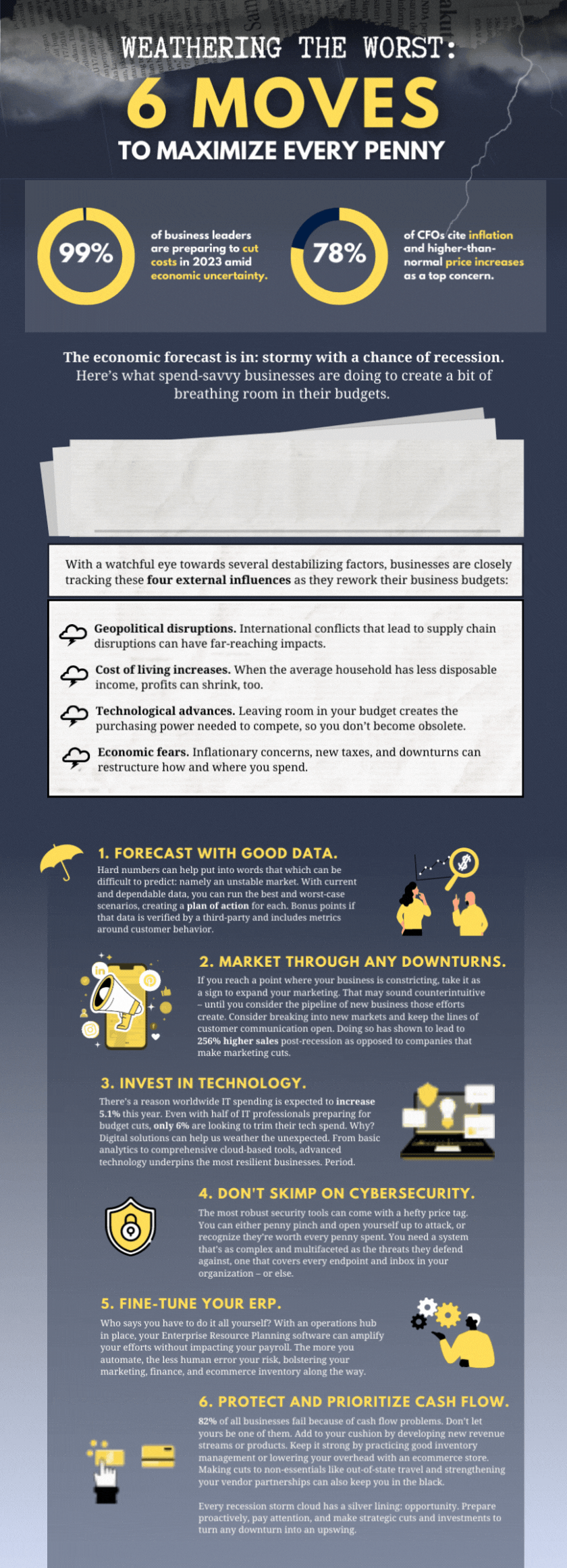Financial Resilience Guide: 6 Moves to Maximize Business Success
Overview
In today's fast-paced business landscape, small and medium-sized companies face a host of challenges that can impact their financial stability and success. From external influences like geopolitical disruptions and inflation to technological advances and economic features, the list of potential hurdles is extensive. To navigate these turbulent waters successfully, it's crucial for businesses to have a strategic plan in place. In this comprehensive guide, we'll explore how to weather the worst by making six key moves to maximize every penny. Whether you're a government buyer, a small business owner, or a patriotic consumer, these strategies can help ensure your financial well-being in any economic climate.
External Influences and Challenges
Before delving into the six moves that can help you maximize your resources, let's take a closer look at the four external influences and issues that every small and medium-sized company should be aware of:
1. Geopolitical Disruptions
In an interconnected world, geopolitical events can send shockwaves through the business world. Trade tensions, international conflicts, and shifting alliances can disrupt supply chains, affect markets, and create uncertainty for businesses of all sizes. Staying informed and agile in the face of geopolitical disruptions is essential for financial resilience.
2. Inflation and Cost of Living Increases
Inflation is an economic reality that can erode the purchasing power of both businesses and consumers. When the cost of goods and services rises, maintaining profitability becomes a significant challenge. Companies need strategies to adapt to inflation, whether it's by adjusting pricing, optimizing supply chains, or seeking cost-saving opportunities.
3. Technological Advances
The rapid pace of technological innovation has transformed the business landscape. While technology can offer numerous benefits, it also presents challenges. Staying competitive and efficient often requires investing in new technologies, but the wrong investments can lead to financial setbacks. Companies must carefully assess which technologies are relevant to their operations and budget accordingly.
4. Economic Features
Economic features, including interest rates, government policies, and economic cycles, can have a profound impact on businesses. Recessions and economic downturns can strain finances, while favorable conditions can provide growth opportunities. Companies should be prepared to adapt their strategies to navigate various economic features.
Your 6 Moves to Weather the Storm
Now that we've explored the external influences and issues, let's dive into the six moves that can help your business weather the worst and maximize every penny.
Move 1. Forecast with Good Data
Accurate forecasting is the cornerstone of financial stability. By analyzing historical data, market trends, and relevant economic indicators, businesses can make informed decisions about resource allocation, pricing, and inventory management. Leveraging data analytics and predictive tools can provide valuable insights to guide your business through uncertain times.
Move 2. Market Through Any Downturns
Marketing is not a discretionary expense; it's an essential investment in your company's future. During economic downturns, some businesses may be tempted to cut their marketing budgets. However, this can lead to reduced visibility and a loss of market share. Instead, consider shifting your marketing strategies to align with changing consumer behaviors and preferences. Embrace digital marketing and social media to maintain engagement with your audience.
Move 3. Invest in Technology
As mentioned earlier, technological advances are both a challenge and an opportunity. Invest wisely in technology that enhances efficiency, streamlines operations, and improves customer experiences. Cloud-based solutions, automation, and e-commerce platforms can empower your business to adapt to changing market conditions and stay competitive.
Move 4. Don't Skimp on Cybersecurity
In an era of digital transformation, cybersecurity is non-negotiable. The cost of a data breach or cyberattack can be crippling, both financially and reputationally. Invest in robust cybersecurity measures to protect sensitive data and customer trust. Regularly update security protocols, conduct employee training, and consider third-party assessments to identify vulnerabilities.
Move 5. Fine-Tune Your ERP (Enterprise Resource Planning)
Efficient resource management is crucial for cost control. An ERP system can help you optimize your company's resources by providing real-time data on inventory, production, and finances. Streamlining processes and reducing waste can lead to significant cost savings. Ensure that your ERP system is tailored to your specific needs and regularly updated to stay current with industry best practices.
Move 6. Protect and Prioritize Cash Flow
Cash flow is the lifeblood of any business. Ensure that you have a robust cash flow management strategy in place. Monitor accounts receivable, negotiate favorable payment terms with suppliers, and consider financing options to bridge gaps in cash flow. A strong financial buffer can help your business weather unexpected challenges without resorting to high-interest loans or cutting essential expenses.
Summary
In conclusion, small and medium-sized businesses must be prepared to navigate external influences and issues while maximizing their financial resources. By implementing these six moves – forecasting with good data, marketing through downturns, investing in technology, fine-tuning your ERP, prioritizing cybersecurity, and protecting cash flow – you can position your company for long-term financial stability and success. Remember that adaptability and resilience are key to weathering the worst and thriving in any economic climate.


